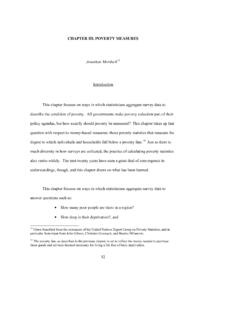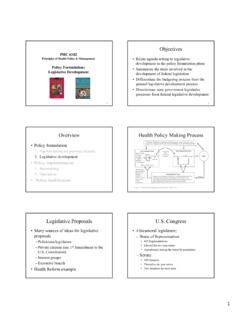Transcription of The french health care system - Robert F. Wagner Graduate ...
1 The french health care systemWorld Hospitals and health Services - Universal health Coverage (UHC): Making progress towards the 2030 targets Vol. 54 No. 149 VICTOR RODWINPROFESSOR OF health POLICY AND MANAGEMENTWAGNER SCHOOL OF PUBLIC SERVICE, NEW YORK UNIVERSITYNEW YORK, USAThe french health care french health care system is a model of national health insurance (NHI) that provides health care coverage to all legal residents. It is not an example of socialized medicine, Cuba. It is not an example of a national health service, as in the United Kingdom, nor is it an instance of a government-run health care system like the United States Veterans health Administration. french NHI, in contrast, is an example of public, social security and private health care financing, combined with a public-private mix in the provision of health care services. The french health care system reflects three underlying political values (Rodwin, 1981): 1.
2 Liberalism, in the sense of giving patients free choice of doctors and hospitals; 2. pluralism, in offering diverse health care delivery options ranging from private fee-for-service practice, health centers and outpatient hospital consultations for ambulatory care, through a range of public, non-profit and for-profit hospitals; 3. solidarity, in the sense of having those with greater wealth and better health finance services for those who are less well-off and in poorer health . In practice, the french health system represents a delicate balance between NHI and private fee-for-service practice la m decine lib rale (Rodwin, 2003; Rodwin and LePen, 2004; Steffen, 2010). The tensions involved in achieving universalism, respecting liberalism and meeting the challenge of rising inequalities are often highlighted in attempting to characterize the distinguishing features of french NHI (Nay et.)
3 Al. 2016; Steffen 2016). Also, the question of whether the system is sustainable, recurs with regularity (Rodwin and contributors, 2006). In this article, I provide a brief overview of how french NHI evolved since World War II; its financing, health care organization and coverage; and most importantly, its overall performance. Evolution, coverage, financing and organizationEvolution: french NHI evolved in stages and in response to demands for extension of coverage. Following its original passage, in 1928, the NHI program covered salaried workers in industry and commerce whose wages were under a low ceiling (Galant, 1955). In 1945, NHI was extended to all industrial and commercial workers and their families, irrespective of wage levels. The extension of coverage took the rest of the century to complete. In 1961, farmers and agricultural workers were covered; in 1966, independent professionals were brought into the system ; in 1974 another law proclaimed that NHI should be universal.
4 It wasn t until January 2000 that comprehensive first-dollar health insurance coverage was granted to the remaining uninsured population, on the basis of residence in France (Boisguerin, 2002). NHI forms an integral part of France s Social Security system , which is typically referred to by means of an agrarian metaphor, as a set of three sprouting branches: 1) pensions; 2) family allowances; 3) health insurance and workplace accident coverage (Damon and Ferras, 2015). The first two are managed by a single national fund whereas the third branch is run by three main NHI funds: for Salaried Workers (CNAMTS); for farmers and agricultural workers (MSA); and for independent Professionals (RSI) (Bras and Tabuteau, 2015). In addition, there are eleven smaller funds for specific occupations and their dependents, each defending their rightfully earned entitlements. The CNAMTS covers 86 percent of legal residents in France which includes salaried workers, those recently brought into the system because they were uninsured, and the beneficiaries of seven of the smaller funds administered by CNAMTS.
5 All NHI funds are legally private organizations responsible for the provision of a public service. In practice, they are quasi-public organizations supervised by the government Ministry that oversees french Social Security. The main NHI funds have a network of local ABSTRACT: The french health care system is a model of national health insurance (NHI) that provides health care coverage to all legal residents. It is an example of public social security and private health care financing, combined with a public-private mix in the provision of health care services. The french health care system reflects three underlying political values: liberalism, pluralism and solidarity. This article provides a brief overview of how french NHI evolved since World War II; its financing health care organization and coverage; and most importantly, its overall health Coverage (UHC): Making progress towards the 2030 targetsWorld Hospitals and health Services - Universal health Coverage (UHC): Making progress towards the 2030 targets Vol.
6 54 No. 150and regional funds that process reimbursement checks for health care providers and/or patients, look out for fraud and abuse, and provide a range of customer services for their beneficiaries. Coverage and Benefits: french NHI covers services ranging from hospital care, outpatient services, prescription drugs (including homeopathic products), spa treatments, nursing home care, cash benefits, and to a lesser extent, dental and vision care. Small differences in coverage remain among different NHI funds. Smaller funds with older, higher-risk populations, farmers, agricultural workers and miners, are subsidized by the CNAMTS, as well as by the state, on grounds of what is termed demographic compensation. Retirees and the unemployed are automatically covered by funds according to their occupational categories. Financing: As of 2016, public health care expenditures accounted for 79 percent of total health care spending (DRESS, 2016).
7 Private voluntary health insurance (VHI) accounted for another 13 percent and out-of-pocket payments around 8 percent. Of the total public portion, social security payroll taxes accounted for 64 percent of the total. The remainder was financed by a national income tax on all earnings, including dividends and interest from capital (16%), revenues from a tax on tobacco, alcohol, the pharmaceutical industry and private voluntary health insurance (VHI) (12%), state subsidies (2%) and contributions from other branches of social security (6%). health Care Organization: Liberalism is correctly invoked as underpinning the medical profession s attachment to cost-sharing and selected elements of la m decine lib rale (private fee-for-service practice): selection of the physician by the patient, freedom for physicians to practice wherever they choose. Likewise, the diverse forms of practice in ambulatory care private office-based arrangements that still prevail, along with growing numbers of health care centers and hospital-based consultations reflect the importance of pluralism in french medical practice.
8 As for hospitals, most acute beds are public (two-thirds), with the remaining third consisting of private beds divided among commercial for-profit and private not-for profit, usually affiliated with the public hospital french health care system is worthy of attention from health policymakers worldwide, for three reasons. First, France is among those countries that enjoy the highest levels of population health among wealthy nations. Second, France ranks #1 among OECD nations on an important indicator of health system performance avoidable mortality. Third, the french have easy access to primary health care, as well as specialty services, at less than half the per capita cost (Table 1) of what is spent in the Population health statusHealth systems are often compared and ranked, based on their population s health status. Insofar as access to public health services and medical care can significantly improve a population s health , this is a good starting point in evaluating a health system .
9 Whether one compares life expectancy at birth, life expectancy at 65 years, infant mortality rates, or years of life lost due to premature death, France performs better than the (Table 1). France is also noted for having the highest longevity for women, after Japan. These indicators, however, are not sufficient for assessing the system s performance, because they reflect many other important determinants of health , poverty rates (Figs. 1-2); other socio-economic disparities; maternal and child health programs; work and family policies; and nutrition. Although the spends more on health care as a share of GDP, than any other nation, France spends a significantly higher share of its GDP on social service programs, particularly on family support and employment training programs (Fig. 3). An important hypothesis to investigate is whether France s government spending on these programs contributes to the population s impressive population health system indicatorsFrance s claim to fame with respect to health system performance is its top ranking among wealthy OECD nations, based on its success in averting deaths from a range of curable cancers, pneumonia, ischemic heart disease, maternal deaths in childbirth, and a host of other causes of mortality considered to be amenable to health care interventions.
10 Avoidable mortality (AM) attempts to capture the extent to which deaths under the age of 75 years would not have occurred, had the population benefitted from access to effective disease prevention programs, primary care, as well as specialty services. Based on a comparison of avoidable mortality among 19 OECD nations, France has the lowest rate (ranks #1) and the has the highest rate (ranks #19) (Nolte and McKee, 2008). Moreover, between 1999-2007, the percentage decline in AM in France ( ) was higher than in the ( ) (Nolte and McKee, 2012). Based on these findings, Nolte and McKee estimate that if the were to achieve levels of AM of the three top-performing countries (France, Japan and Australia), about 101,000 deaths could be exclusive focus on AM does not allow one to disentangle the consequences of poor access to disease prevention versus primary or specialty health care services.













